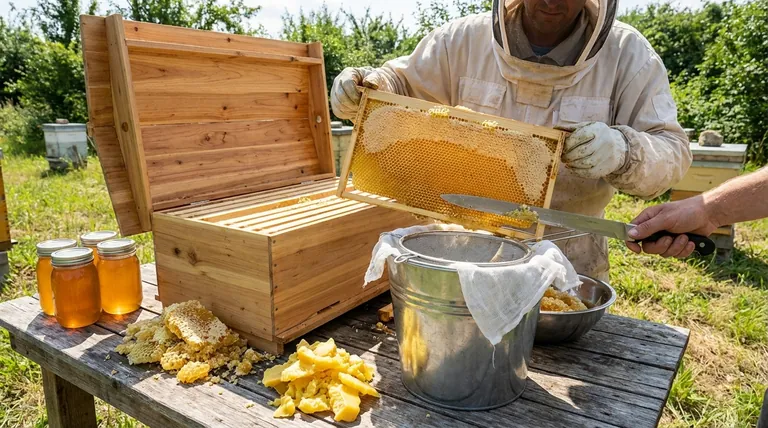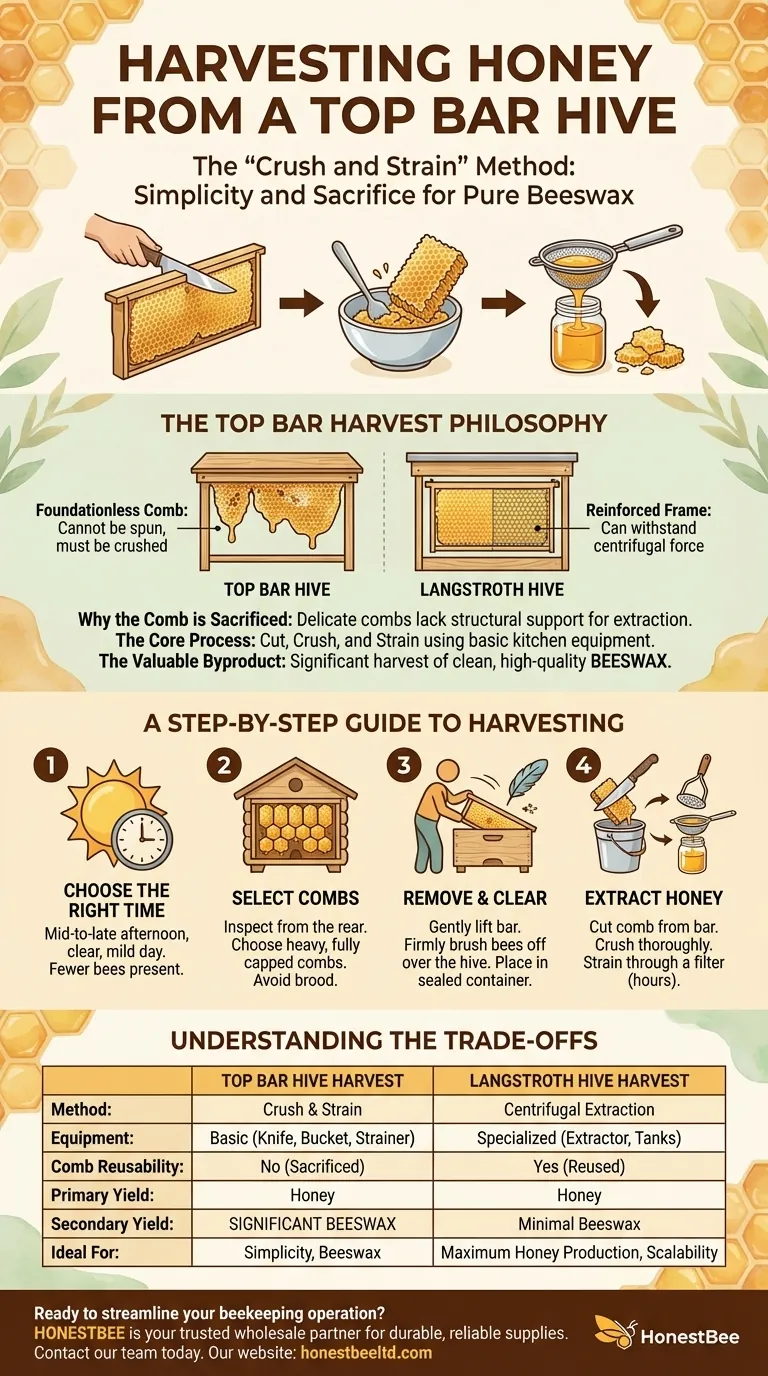To harvest honey from a top bar hive, you must physically remove the entire comb from the top bar, clear it of bees, and then extract the honey using a "crush and strain" method. This process does not require specialized or expensive equipment like a centrifugal extractor. Because the honeycomb is destroyed in the process, it cannot be returned to the hive for the bees to refill.
The core principle of a top bar hive harvest is its simplicity and the sacrifice of the comb. While this leads to lower honey yields compared to frame-based hives, it provides a significant and valuable secondary harvest of pure beeswax.

The Top Bar Harvest Philosophy
The design of a top bar hive dictates its harvest method. Unlike the rigid, reinforced frames of a Langstroth hive, top bar combs are built freely by the bees from a single point of contact.
Why the Comb is Sacrificed
The delicate, foundationless combs in a top bar hive are attached directly to the wooden bar. They lack the structural wiring and wooden frame needed to withstand the centrifugal force of a mechanical honey extractor.
Therefore, the only practical way to release the honey is to break down the comb's structure entirely.
The Core Process: Cut, Crush, and Strain
The method is straightforward and can be done with basic kitchen equipment. The comb is cut from the bar, crushed to break open the wax cells, and the resulting mix of honey and wax is poured through a filter to separate them.
The Valuable Byproduct: Beeswax
Because you harvest the entire comb, a top bar hive produces a substantial amount of clean, high-quality beeswax. This wax is a valuable resource for making candles, cosmetics, or wood polish, providing a significant secondary yield from your hive.
A Step-by-Step Guide to Harvesting
Executing a calm and efficient harvest is key to minimizing stress on both the beekeeper and the colony.
1. Choose the Right Time
The ideal time to harvest is mid-to-late afternoon on a clear, mild day. At this time, a large portion of the hive's foragers will be out of the hive, meaning fewer bees are present to notice and defend their stores.
2. Select the Combs for Harvest
Begin your inspection at the rear of the hive, furthest from the entrance. The brood nest (where the queen lays eggs) is typically near the front, while honey is stored in the back.
Look for combs that are heavy and mostly "capped"—meaning the bees have sealed the individual cells with a white wax covering. This indicates the honey is ripe and has the correct moisture content. Leave any combs containing brood or large amounts of pollen.
3. Remove the Comb and Clear the Bees
Gently lift the selected top bar straight up. The quickest way to clear the comb is to hold it over the open hive and firmly brush the bees off with a bee brush or a soft feather.
Work quickly but gently. Place the bee-free comb into a sealed, food-grade container to prevent robbing from nearby bees.
4. Extract the Honey
Once indoors, use a long knife to cut the comb off the top bar, letting it fall into a clean, food-grade bucket. Use a masher or your clean hands to crush the comb thoroughly.
To strain, you can use a purpose-built bucket-top strainer or simply stretch a clean paint strainer bag or layers of cheesecloth over a second bucket. Pour the crushed honey and wax mixture through the filter and let gravity do the work. This can take several hours.
Understanding the Trade-offs
The top bar method is philosophically different from other systems, and it's critical to understand the consequences of that difference.
Lower Honey Yield vs. Langstroth Hives
The biggest trade-off is honey production. Bees expend enormous energy secreting wax and building comb. Because the top bar hive must rebuild every harvested comb from scratch, its energy is diverted from nectar collection, resulting in a lower overall honey yield compared to a Langstroth hive where drawn comb is reused year after year.
Simplicity vs. Specialized Equipment
The top bar harvest is defined by its simplicity. You need little more than a knife and a bucket. In contrast, a frame-based harvest requires a significant investment in equipment, including a centrifugal extractor, an uncapping knife, and uncapping tanks.
Hive Impact and Recovery
Removing entire combs constitutes a significant event for the colony. The hive suffers a temporary setback as it must dedicate resources to replacing the lost wax structure. This is a fundamental part of the top bar beekeeping cycle.
Making the Right Choice for Your Goal
Your beekeeping philosophy should dictate your harvest method.
- If your primary focus is maximum honey production: A Langstroth hive system that allows for the reuse of drawn comb is a more efficient choice.
- If your primary focus is simplicity and minimal equipment: The top bar hive's crush-and-strain method is ideal, requiring no specialized machinery or large initial investment.
- If your primary focus is a holistic harvest of both honey and beeswax: The top bar method is superior, as it is the only system that guarantees a large and valuable wax harvest as an intrinsic part of the process.
By understanding this fundamental trade-off between yield and simplicity, you can perform your harvest with confidence, knowing it aligns perfectly with your goals.
Summary Table:
| Aspect | Top Bar Hive Harvest | Langstroth Hive Harvest |
|---|---|---|
| Method | Crush and Strain | Centrifugal Extraction |
| Equipment Needed | Knife, Bucket, Strainer | Extractor, Uncapping Knife, Tanks |
| Comb Reusability | No (Comb is sacrificed) | Yes (Comb is reused) |
| Primary Yield | Honey | Honey |
| Secondary Yield | Significant beeswax | Minimal beeswax |
| Ideal For | Simplicity, minimal equipment, beeswax production | Maximum honey production, scalability |
Ready to streamline your beekeeping operation?
Whether you manage a few top bar hives or supply equipment to a network of commercial apiaries, HONESTBEE is your trusted wholesale partner. We provide the durable, reliable supplies that beekeepers depend on for a successful harvest season.
Let's discuss your needs: Contact our team today to explore our full catalog of wholesale beekeeping equipment and supplies.
Visual Guide

Related Products
- Long Langstroth Style Horizontal Top Bar Hive for Wholesale
- HONESTBEE Advanced Ergonomic Stainless Steel Hive Tool for Beekeeping
- Professional Dual-End Stainless Steel Hive Tool for Beekeeping
- Metal Bee Hive Stand Bee Box Stand for Beekeeping
- Professional 3-Bar Frame Grip with Integrated Hive Tool
People Also Ask
- What are the benefits of the top bar hive? A Guide to Ergonomic, Natural Beekeeping
- What is a top bar bee hive? A Natural, Low-Stress Beekeeping Solution
- How are entrances designed in top bar hives? Master Beehive Layout for Maximum Honey
- What are the box management requirements for a top bar hive vs. Langstroth? Choose Your Hive Strategy
- What are the benefits of a top bar hive? A Natural, Low-Impact Approach to Beekeeping



















